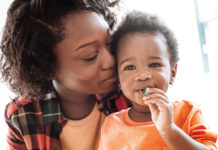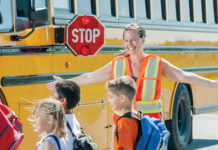
If you’re looking for a list of safety rules for kids to help lay the groundwork for the things you should be educating your children about, this post has 11 tips and ideas to help you get started.
As parents, there’s nothing we want more than to protect our little ones and keep them safe. We baby-proof our homes once they start crawling, take them to the doctor when they’re sick, advocate for them when they can’t speak for themselves, and worry about them constantly. And while certain safety rules for kids come naturally to us – like teaching our children to look both ways before crossing the street – we often underestimate how many other things we need to teach them.
From stranger danger, to body safety, to empowering your child to say NO, this collection of safety rules for kids will help lay the groundwork for the kinds of conversations you need to have with your children.
11 Safety Rules for Kids
1) Full Name, Phone Number, and Address
Of all of the safety rules for kids you need to worry about, this one probably feels like the most obvious, yet very few of us take the time to ensure this information is ingrained in our children’s memories. We assume if our children know their first name, all is good in the world, and forget they need to know their full legal first and last names, as well as their phone number and address as well. And to complicate things further, they also need to know they shouldn’t be sharing this information with just anyone – it should only be provided in emergency situations, like when they’re lost, if there’s been an accident, etc.
Pro Tip: If your child has special needs that may preclude him or her from being able to verbalize this information, or has a tendency to shut down in emergency-type situations, think outside the box. Write the information on a card your child can easily access (i.e. you can store it in the front pocket of his or her backpack), teach your child to type the information on a smart phone, etc.
2) Your Full Name and Phone Number
In addition to knowing his or her own name, phone number, and address, you child also needs to know your full name and how you can be reached during the day (i.e. your cell phone number). Many of us take for granted that our children know our full names, but oftentimes they only know us as ‘mom’ or ‘dad’!
3) How to Call 911
If your child knows his or her full name, your full name, and your address and phone number, he or she will be better equipped to call 911 in the case of an emergency. Of course, you can’t assume your child will know how to do this, or that he or she will understand when it’s appropriate. Your child should know to call 911 in the event of a fire, accident, or medical emergency, or when he or she has been approached by a stranger who is trying to lure him or her. Take the time to review this information with your child, provide clear examples of situations where he or she should call 911, and then practice (without actually calling!) to ensure your little one knows what to do.
4) Stranger Danger
This is another one of those safety rules for kids that can be a bit tricky. As tempting as it is to tell our little ones not to talk to ANY strangers, we need to teach them that not all strangers are bad. We encounter strangers all the time – on the street, in the grocery store, at our local coffee shop, etc. – and instead of instilling fear into our children that makes them think everyone is evil, we need to teach them how to recognize dangerous situations. Someone who holds open a door for us, says hello, or tells us a joke while we’re waiting in line at the grocery store is probably harmless. A stranger who asks your child for help, offers him or her something as a lure (candy, a toy, etc.), and/or who tries to get your child to go somewhere with them should always be considered dangerous.
5) How to Find a Safe Place When In Danger
If your child ever finds him- or herself in danger, it’s important he or she knows how to find help. Teach him or her to go into a busy establishment (store or restaurant) if he or she feels unsafe while out, and have an open discussion between your child and your neighbors so your little one knows where they can turn if there’s ever an emergency at home.
6) If Lost, Don’t Move!
When I was 4, my dad lost me at the mall, and the moment I realized we had been separated, I bolted and got swept up into a crowd of Saturday shoppers. Thankfully, an older couple saw me crying and took me to the information booth where they paged my dad to come and get me, and I learned my lesson: when you’re lost, don’t move! Of course, this can be difficult to do when you’re feeling panicked, but remind your child of this every time you are in a crowded space as it will make it much easier for you to find him/her if you are separated.
7) Street Safety
In addition to the obvious things, like looking both ways before crossing the street and understanding and following cross walk signals, there are other street safety rules for kids you need to teach your child, including:
- Look left, right, and then left again before crossing the street
- Put away distractions (toys, phones, headphones, etc.) before crossing the street
- Cross at a marked cross walk wherever possible
- When walking in a residential neighborhood, stop before driveways to ensure cars are parked (pay attention to taillights and whether there is someone in the car)
- Don’t walk between parked cars
8) The Rules of Touching
While it may have been normal for you to kiss and/or hug friends and relatives each time you saw them when you were a kid, never (ever) enforce this rule on your own child. Your child needs to know he or she has complete ownership over his or her body, and if they don’t feel comfortable touching someone else, they should feel empowered to say no.
9) Body Parts
I’m the first to admit that when my daughter was a toddler, I felt embarrassed using proper names for her private parts, and opted for cute options instead. I have since learned that this is a big no no when it comes to safety rules for kids. Using the proper names of our (private) body parts puts our children in a position of power to communicate if there are any issues with those areas of their bodies. They can accurately tell you where they might be feeling pain or discomfort, and if something untoward were to happen to them, using proper names gives more credit to their story. If they say, ‘so-and-so touched my cookie’ to another child in a classroom setting, for example, a teacher may not pick up on the subtleties. But if a child says, ‘so-and-so touched my vagina’, the magnitude of the situation is far less likely to be overlooked.
It has also been suggested that children who are familiar with the names of their body parts – and comfortable talking about them – may be less vulnerable to predators. Remind your child that no one is to touch them in the areas their bathing suit covers, and that you, your spouse, and your child’s doctors are the only people that should ever see those areas of your child’s body. Your child should never show their private parts to others, should never allow others to photograph those parts of their body, and should never be exposed to another person’s private parts.
As you can see, this is one of the trickier safety rules for kids, and I can’t stress enough how important it is that your child knows he or she can be open and honest with you about their body.
10) No Secrets at Home
While it can be fun sharing secrets around gifts and special occasions, I’m a huge proponent of the ‘no secrets at home’ policy. Remember that predators and people who want to harm your child may make threats that make your child feel scared to tell you the truth. Your child needs to know you and your home are safe places, and that he or she can tell you anything without fearing punishment or judgement. Choosing a ‘safe word’ your child can use to alert you to something unsafe is a great idea to consider as your child can indirectly tell you something is wrong, and you can then use your creativity to allow him or her to open up to you.
11) No Means No!
The last item on my list of safety rules for kids is to teach your little one from a young age that NO MEANS NO! Your child is allowed to say no to anything that makes him or her uncomfortable, and it’s up to you to not only teach them how to do this, but to encourage them to use their voice!
It’s never too early to start teaching your kids about safety, and I hope this collection of safety rules for kids proves useful to you!













